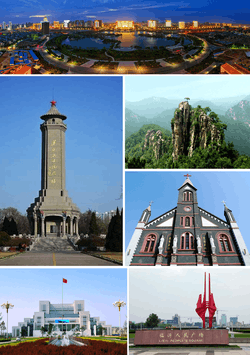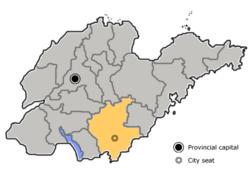Linyi
Linyi (simplified Chinese: 临沂; traditional Chinese: 臨沂; pinyin: Línyí) is a prefecture-level city in the south of Shandong province, China. As of 2011, Linyi is the largest prefecture-level city in Shandong, both by area and population, Linyi borders Rizhao to the east, Weifang to the northeast, Zibo to the north, Tai'an to the northwest, Jining to the west, Zaozhuang to the southwest, and the province of Jiangsu to the south. The name of the city Linyi (临沂) literally means "close to the Yi River".
Linyi 临沂市 Lini | |
|---|---|
 Clockwise from top: A view of the Beicheng New District skyline, Mount Meng, Cathedral of Linyi, Linyi People's Square, The Library of Linyi University, and The Memorial Tower of Revolutionary Martyrs | |
 Location of Linyi City jurisdiction in Shandong | |
| Coordinates (Linyi municipal government): 35°06′14″N 118°21′23″E | |
| Country | People's Republic of China |
| Province | Shandong |
| County-level divisions | 12 |
| Township-level divisions | 181 |
| Municipal seat | Lanshan District |
| Government | |
| • CPC Secretary | Vacant |
| • Mayor | Meng Qingbin (孟庆斌) |
| Area | |
| • Prefecture-level city | 17,191.21 km2 (6,637.56 sq mi) |
| • Urban | 2,293.3 km2 (885.4 sq mi) |
| • Metro | 2,293.3 km2 (885.4 sq mi) |
| Elevation | 74 m (244 ft) |
| Population (2010 census) | |
| • Prefecture-level city | 10,039,440 |
| • Density | 580/km2 (1,500/sq mi) |
| • Urban | 2,303,648 |
| • Urban density | 1,000/km2 (2,600/sq mi) |
| • Metro | 2,303,648 |
| • Metro density | 1,000/km2 (2,600/sq mi) |
| Time zone | UTC+8 (China Standard) |
| Area code(s) | 0539 |
| ISO 3166 code | CN-SD-13 |
| License Plate Prefix | 鲁Q |
| Administrative division code | 371300 |
| Línyí | |||||||||||||
|---|---|---|---|---|---|---|---|---|---|---|---|---|---|
| Simplified Chinese | 临沂 | ||||||||||||
| Traditional Chinese | 臨沂 | ||||||||||||
| Literal meaning | close to the Yi River | ||||||||||||
| |||||||||||||
The city recently expanded along the Yi River to Nanfang, under the slogan "Grand Linyi, Beautiful Linyi, New Linyi". Multiple recreational parks were built, along with new school campuses etc. The development is a consequence of a series of governmental projects, including relocate the city government, which is expected to stimulate the economy.
The population was 10,039,440 at the 2010 census, of which 2,303,648 lived in the built-up area made up of Lanshan District, Luozhuang District and Hedong District.[1]
Administration
The prefecture-level city of Linyi administers 12 county-level divisions, including three districts and nine counties.
| Map | ||
|---|---|---|
| Subdivision | Chinese | Pinyin |
| Lanshan District | 兰山区 | Lánshān Qū |
| Luozhuang District | 罗庄区 | Luózhuāng Qū |
| Hedong District | 河东区 | Hédōng Qū |
| Yinan County | 沂南县 | Yínán Xiàn |
| Tancheng County | 郯城县 | Tánchéng Xiàn |
| Yishui County | 沂水县 | Yíshuǐ Xiàn |
| Lanling County | 兰陵县 | Lánlíng Xiàn |
| Fei County | 费县 | Fèixiàn |
| Pingyi County | 平邑县 | Píngyì Xiàn |
| Junan County | 莒南县 | Jǔnán Xiàn |
| Mengyin County | 蒙阴县 | Méngyīn Xiàn |
| Linshu County | 临沭县 | Línshù Xiàn |
The city is further divided into 181 township-level divisions.
History
Linyi has a history of 2400 years. It is home to many historical figures, notably Zhuge Liang and Wang Xizhi. In 1972, the Sun Tzu's Art of War was first discovered here,[2][3] along with other classics on hand written bamboo slips. Sun Tzu's Art of War is currently in display at Shandong Provincial museum.
In the spring of 1938, during the Second Sino-Japanese War, the city was the scene of fierce fighting between Chinese and Japanese troops. The civilians were encouraged by army victory in the Battle of Tai'erzhuang, which was nearby, defended Linyi fiercely, but Japanese soldiers breached the walls on April 19, 1938. The defenders withdrew the next day to another contested area 30 miles away.
In 1946, during the Chinese Civil War, the communist Directorate General of Shandong Wartime Posts was moved from the Yimeng Mountains to Linyi and renamed the Shandong Provincial Postal Administration.[4]
After the People's Republic of China was founded in October 1949, the administrative division was adjusted.
In 2005, Linyi drew international attention as a center of human rights abuses related to the enforcement of China's controversial family planning policies. Following widespread allegations of violence and coercion in excess of Chinese law, local human rights defender Chen Guangcheng filed a class action lawsuit on behalf of the victims. The local Chinese courts refused to hear the case and imprisoned Chen Guangcheng on charges of fomenting state resistance.[5] Due in part to the severity and scope of these abuses Linyi has been used by activists to criticize China's violation of women's rights.[6]
Geography
Linyi is in the south of Shandong province, not far from the ports of Rizhao, Lanshan District, Rizhao and Lianyungang. It is along the G2 Beijing–Shanghai Expressway as well as the Eurasian Land Bridge. The urban area lies on mostly flat land that gives way to more rugged terrain in the west and northwest of the city's administrative area, which covers 17,184 km2 (6,635 sq mi).
Climate
Linyi has a monsoon-influenced climate with generous summer precipitation, cold, dry winters, and hot, humid summers. Under the Köppen climate classification, it is in the transition from the humid subtropical zone (Cwa) to the humid continental zone (Dwa), though favouring the former. More than half of the annual precipitation of 833 mm (32.8 in) falls in July and August alone, and the frost-free period is above 200 days.
| Climate data for Linyi (1981–2010 normals) | |||||||||||||
|---|---|---|---|---|---|---|---|---|---|---|---|---|---|
| Month | Jan | Feb | Mar | Apr | May | Jun | Jul | Aug | Sep | Oct | Nov | Dec | Year |
| Average high °C (°F) | 4.4 (39.9) |
7.5 (45.5) |
13.0 (55.4) |
20.3 (68.5) |
25.8 (78.4) |
29.4 (84.9) |
30.7 (87.3) |
30.0 (86.0) |
26.5 (79.7) |
21.2 (70.2) |
13.4 (56.1) |
6.6 (43.9) |
19.1 (66.3) |
| Daily mean °C (°F) | −0.5 (31.1) |
2.2 (36.0) |
7.2 (45.0) |
14.2 (57.6) |
19.9 (67.8) |
23.9 (75.0) |
26.4 (79.5) |
25.7 (78.3) |
21.4 (70.5) |
15.6 (60.1) |
8.1 (46.6) |
1.7 (35.1) |
13.8 (56.9) |
| Average low °C (°F) | −4.3 (24.3) |
−2.0 (28.4) |
2.4 (36.3) |
8.9 (48.0) |
14.6 (58.3) |
19.3 (66.7) |
23.0 (73.4) |
22.3 (72.1) |
17.4 (63.3) |
11.1 (52.0) |
3.7 (38.7) |
−2.2 (28.0) |
9.5 (49.1) |
| Average precipitation mm (inches) | 12.0 (0.47) |
16.0 (0.63) |
24.1 (0.95) |
32.7 (1.29) |
77.1 (3.04) |
94.5 (3.72) |
235.1 (9.26) |
193.1 (7.60) |
72.0 (2.83) |
41.2 (1.62) |
24.5 (0.96) |
10.5 (0.41) |
832.8 (32.78) |
| Average precipitation days (≥ 0.1 mm) | 3.1 | 4.7 | 5.4 | 6.5 | 7.0 | 8.5 | 14.6 | 11.0 | 7.5 | 5.6 | 5.1 | 3.6 | 82.6 |
| Average relative humidity (%) | 61 | 60 | 59 | 59 | 64 | 70 | 82 | 82 | 74 | 68 | 65 | 63 | 67 |
| Source 1: China Meteorological Administration[7] | |||||||||||||
| Source 2: Weather China (precipitation days 1971–2000)[8] | |||||||||||||
Economy
Linyi's economy is based around its wholesale markets.[9] The Linyi Wholesale City is ranked 3rd in its category in China with an annual trade volume of 40 billion RMB (~US$5 billion). The Linyi prefecture has developed more than 1,500 specialized villages, over 80 specialized towns and nearly 800 industrialized agricultural enterprises.
In 2014 the prefecture's GDP was 369 billion RMB. Main industrial products are: textiles, foodstuffs, machinery, electronics, chemicals, building materials, coal, medicines, gold and porcelain. Machinery is exported to Europe, the Americas and south-east Asia. Linyi prefecture has an annual capacity of three million tons of compound fertilizers.
Notable people
- Xun zi (312–230 BCE), philosopher
- Wang Xizhi (303–361), Eastern Jin Dynasty calligrapher
- Zhuge Liang (181–234), statesman and strategist
- He Chengtian (370-447), astronomer, calendarist and mathematician
- Gui Guzi, military strategist, teacher of renowned Warring States generals Sun Bin and Pang Juan. late Warring States
- Xu Datong (1994–present), doctor
Cultural Attractions
Linyi's focal point is the People's Square (Renmin Guangchang). It was built in the early 1990s on the site of an old army barracks. It is about 500 metres (1,600 ft) east-west, and about 300 m (980 ft) north-south. Underneath it is a shopping centre and entertainment facilities.
Just north of the city centre is a park dedicated to Wang Xizhi. For a small entrance fee tourists can enjoy a pleasant walk and try Chinese calligraphy.
Near the center of Linyi city is a museum which houses some original bamboo strips from the Warring States period.
References
- http://www.citypopulation.de/php/china-shandong-admin.php
- "Yinqueshan Han Bamboo Slips" (in Chinese). Shandong Provincial Museum. 24 April 2008. Archived from the original on 29 October 2013.
- Jonathan Clements (21 June 2012). The Art of War: A New Translation. Constable & Robinson Ltd. pp. 77–78. ISBN 978-1-78033-131-7.
- The Postage Stamp Catalogue of the Chinese People's Revolutionary War Period, published by the China Postage Stamp Museum
- Pan, Philip P. (July 8, 2006). "Chinese to Prosecute Peasant Who Resisted One-Child Policy". Washington Post. Retrieved November 2, 2011.
- "Transcript: An Evaluation of 30 Years of the One-Child Policy in China" (PDF). Tom Lantos Human Rights Commission. Archived from the original (PDF) on April 6, 2012. Retrieved November 2, 2011.
- 中国气象数据网 - WeatherBk Data (in Chinese). China Meteorological Administration. Retrieved 2020-04-14.
- From a booklet compiled by the Linyi Municipal People's Government (2003)
External links
| Wikimedia Commons has media related to Linyi. |
- Government website of Linyi (in Chinese and English)
